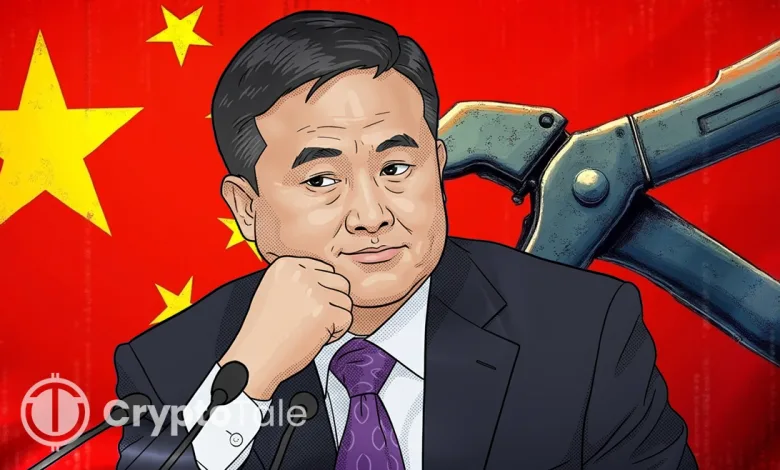PBOC Governor Warns Stablecoins Threaten Global Stability

- PBOC warns stablecoins threaten global financial stability and monetary sovereignty.
- China will sustain its crypto crackdown while monitoring overseas stablecoin expansion.
- Leaders agree that stablecoins lack proper anti-money laundering and compliance oversight.
At the 2025 Financial Street Forum in Beijing, People’s Bank of China Governor Pan Gongsheng warned that stablecoins pose increasing risks to global financial stability and national monetary sovereignty.
Speaking on Monday, Pan said stablecoins amplify weaknesses in global regulation, enabling money laundering, illicit transfers, and terrorist financing across borders. His comments followed recent discussions at the IMF and World Bank Annual Meetings in Washington, where international finance leaders voiced similar concerns.
Concern Over Compliance Gaps
Pan said global regulators are cautious about stablecoins, which have expanded fast but still fail to meet basic compliance standards. He noted that many stablecoin projects lack adequate customer identification and anti-money laundering measures.
According to Pan, this regulatory shortfall creates serious vulnerabilities that could be exploited for illegal cross-border transactions and unmonitored capital flows. These concerns, he explained, were widely shared among finance ministers and central bank governors during last month’s meetings in Washington.
The discussions revealed a growing consensus that stablecoins, despite being pegged to traditional fiat currencies like the U.S. dollar, have not yet achieved the transparency and oversight required for safe integration into the global financial system.
Pan cautioned that the speculative activity surrounding stablecoins increases systemic fragility. He added that such speculation increases exposure to financial shocks, particularly in emerging economies where regulatory systems are underdeveloped.
China Reaffirms Its Domestic Crypto Crackdown
Reiterating Beijing’s firm stance, Pan confirmed that China will maintain its comprehensive ban on domestic crypto activities. He said the PBOC continues to coordinate with law enforcement agencies to combat trading, mining, and speculative operations within the country. These measures, first introduced in 2017, were designed to protect financial stability, consumer safety, and monetary sovereignty.
“The People’s Bank of China will continue to work with relevant departments to crack down on the operation and speculation of virtual currencies,” Pan stated. He emphasized that these policies are effective and that the central bank will persist in ensuring economic order while following developments in foreign stablecoin markets.
Pan also noted that while stablecoins and other virtual assets have grown in popularity, they are still in the early stages of development. International financial organizations and central banks, he said, are adopting a prudent attitude toward them. This caution shows the unresolved risks tied to unregulated digital asset markets and the absence of a unified global framework for oversight.
Related: Stablecoin Market Hits $300 Billion as USDT Faces New Rivals
Balancing Innovation and Monetary Sovereignty
Pan’s remarks showed China’s broader approach of prioritizing financial security and sovereign control over speculative innovation. The PBOC sees stablecoins as more than just a tech innovation; it also views them as a global power issue.
He cautioned that the growth of foreign stablecoins could weaken how developing countries manage their money. As these coins spread locally, they could hurt national currencies and make it harder to run monetary policy.
China’s stance ties in with its push for the digital yuan, a government-backed option meant to blend digital convenience with state control. Pan said this approach helps protect against the risks seen in private crypto projects.
Recently, Beijing also told major tech firms to halt private stablecoin plans in Hong Kong, reinforcing the state’s control over money and avoiding the market problems that unregulated digital assets can cause.
Meanwhile, global adoption of stablecoins is accelerating. The United States has passed the U.S. GENIUS Act, while Japan launched the world’s first yen-pegged stablecoin earlier this year. These, according to reports, have reduced remittance costs by up to 95% and led to a $10 billion rise in crypto-based transfers.
However, Pan emphasized that the fast growth of such instruments shows the need for stronger international regulatory coordination. He said that unchecked expansion could amplify global risks, especially in regions with limited financial infrastructure.
China’s warning comes as policymakers worldwide face increasing pressure to adapt to digital financial transformation. Pan’s statements show a deliberate balance between embracing innovation and preserving control over national monetary systems.
Meanwhile, PBOC’s firm approach indicates a strategic commitment to financial stability, emphasizing regulation over speculation while shaping global dialogue on digital asset oversight.




